Go Back to current column
NEW: Frank Van Riper Spring Classes…below
Bernie Boston: Farewell to a Friend
Legendary DC shooter loved life as much as he did photography
By Frank Van Riper
Photography Columnist
I can’t remember the first time I met Bernie Boston; I knew him for so long and we covered so many things together. But I’m willing to bet that when we did first meet he told me an awful joke.
I also can’t remember ever seeing Bernie--usually festooned with a couple of Leicas—when he wasn’t also wearing at least one item of his regular getup: cowboy boots, Stetson or bolo tie.
Bernie seemed to love life as much as he loved making photographs, so I really can’t remember ever hearing him utter a mean or thoughtless word. [Which is not to say I never saw Bernie angry. It was a sight to behold Bernie in high dudgeon when some boneheaded cop or Secret Service agent got in the way as Bernie covered a story. And as for those racist punks giving him grief on a country road…read on.]
What I do remember is that Bernie Boston, whose photographs graced the pages of the old Washington Star, the Los Angeles Times and, finally, the Bryce Mountain (Va.) Courier (which he owned in his “retirement” with his wife Peg) was one of the best photojournalists of his generation. A two-time Pulitzer finalist, inducted into the Sigma Delta Chi Hall of Fame, and four-time president of the White House News Photographers Association, Bernie obviously was a photographer’s photographer.
But he also was a dear and close friend to damn near everyone he worked with—and that’s why it will be so hard to remember that he is gone.
Bernard Norman Boston died Tuesday Jan. 22, 2008, at his home in Basye, Va., after a long battle with Amyloidosis, a plasma cell disease. He was 74. His 1967 photo “Flower Power,” a runner-up for the Pulitzer Prize, was perhaps the most iconic photo of the turbulent 60s, showing a long-haired antiwar protestor shoving carnations into the gun barrels of MPs during an anti-Vietnam protest at the Pentagon.
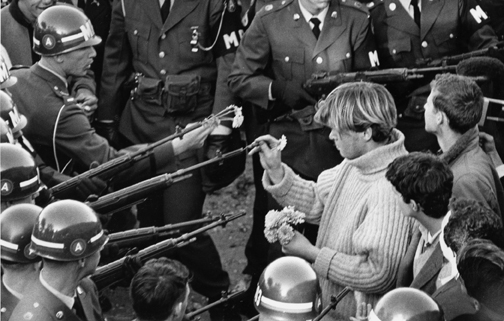
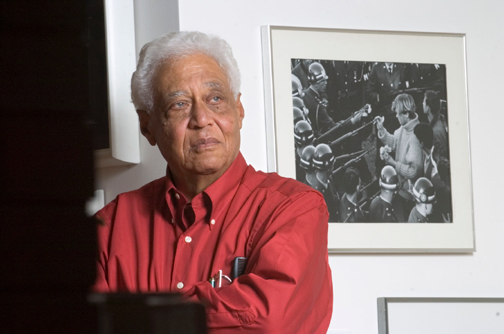
Bernie Boston, one of Washington’s greatest photojournalists, poses beside arguably his most famous picture, Flower Power. Made during an anti-Vietnam War protest at the pentagon, it was a Pulitzer finalist. (portrait by Rich Cooley, Northern Virginia Daily; Flower Power © the estate of Bernie Boston)
Bernie was unique in a number of ways. He was that rarity in DC: a Washington native, born here in 1933 and who grew up in McLean,Va. on land his family had owned for generations. Racially, Bernie was a fine mix as well: American Indian, Irish and African American. He had mocha brown skin, silver hair and a pianist’s long fingers. [Did he ever play the piano? God knows, but I always will have the picture of him lovingly embracing some new photographic toy with those elegant hands.]
I first met Bernie nearly 40 years ago when I was a Washington reporter for the New York Daily News, and we spent many a cold stakeout together, waiting on the comings and goings of political Washington’s famous and/or notorious, oftentimes in the company of “my” photographer, the Daily News’ Harry Hamburg. Later, when I got religion and became a fulltime photographer myself, I always could count on Harry to be at my book signings and openings, along with Bernie, as well as our friends and colleagues George Tames and Paul Hosefros from the NY Times.
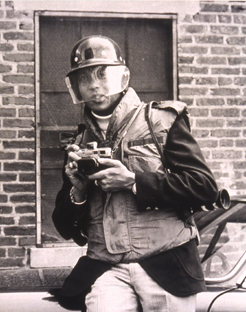 |
| Bernie in his working clothes during the turbulent 60s and 70s. Note the old Leica. (photo courtesy Peggy Boston) |
Bernie had the ability so common in great photographers and journalists (and in great artists in general) to be fascinated by everything around him. People especially fascinated him—their foibles, their faces, their triumphs and tragedies. But almost never their position or their power.
His wife Peggy, who met him when they worked together on the Washington Star recalls:
“I started at The Star on April 24, which happened to be exactly one year after Bernie started there. He began hanging around the promotion department, where I worked, admired my long hair (who didn't have long, straight hair in 1968?) asked me to come to his place so he could take pictures, and on our third date romantically said, ‘We should get married.’
“I knew it was love when he agreed to take pictures for me at the annual newspaper carriers banquet. And I knew he was right when I watched him taking those pictures, completely in the moment for a measly job and looking totally comfortable in his own skin. And I believe it is that very thing, how comfortable he was with who he was, that made him succeed as a photojournalist. No one was ever too insignificant to respect; no one was ever so important to cow to. (As an example, since he died I have had an unhurried call from Senator Pat Leahy and watched a Verizon salesgirl cry when she discovered her customer, Bernie, had died.) This is also why he was every bit as happy taking pictures of everyday life in the Shenandoah Valley as he was on the Washington scene. He absolutely loved it here, and never looked back.”
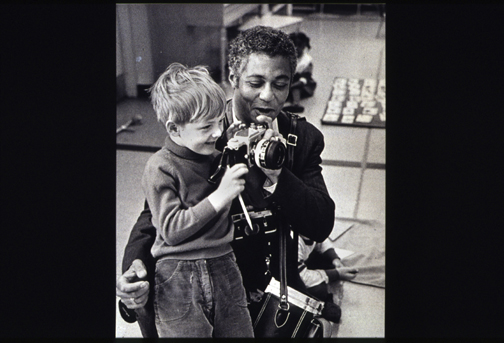
|
|
Bernie’s fascination with, and affection for, people is evident in this wonderful shot of him showing a young boy what exactly is in that funny window on the camera. (photo courtesy Peggy Boston) |
Bernie also loved making mischief (he once stuffed a colleague’s bag with lead weights that the photog unwittingly lugged around for the rest of the day) and telling really awful jokes.
Harry Hamburg remembers “walking up Broadway in NYC with Bernie.... he had stayed overnight with us as he had assignments in NYC, coming in with me on the train....”
“So, we are walking along and he says ‘Did you hear about the new Jewish-Japanese restaurant?’
“I kind of looked over at him, knowing something weird was coming [and] Bernie says...'So-Sue-Me.’
“I immediately turned left onto 21st Street, leaving Bernie walking along, up Broadway by himself... and, of course, talking to himself. Walking half a block before he realized it.”
Then there was Bernie’s Porsche, Harry recalled. “The cop chasing after him speeding away from an assignment... and not catching him even though the cop was on a motorcycle….Or the time some (white) kids were haranguing him on a country road in western Virginia and he pulled out a .45 caliber from the glove box and shot out the engine…”
“We never discussed race,” Peggy Boston remembered. “Bernie is Native American, Irish American and African American....In more recent years, we had discussed how distressing it is that stories on race always look at the problems. There has never been a story on an interracial couple with no problems. Too many interracial couples find discrimination in every look or slight, which could just as well be someone having a bad day. This is not to say there may have been some issues; I just don't know about them and there never were any for us.”
Born in '33, Bernie left the area to go to Rochester Institute of Technology, where he honed his already developing skills as a photographer. After graduating from RIT in 1955, he studied at the School of Aviation Medicine in the Air Force and then served time in the Army, spending two years in Germany as a radiologist in the neurosurgical unit. He was discharged in 1958 and moved back to Washington to work as an assistant manager at Custom Craft Color Service.
In 1963, he left Washington to take a job at the Dayton Daily News in Dayton, Ohio, returning three years later to work at the Washington Star, where he ultimately was promoted to Director of Photography. It was a position he held until the paper folded in 1981. The Los Angeles Times then hired him to start a photo operation in the nation’s capital. Bernie recalled that most of the time he had to figure out what the top news of the day was going to be, then photograph it. He remembered that period as fascinating and challenging—especially late at night and on deadline.
One time, he told me, after racing in from Andrews Air Force Base after covering a presidential trip, he went to the Times Bureau darkroom and hastily started souping his film for the final edition.
[Too hastily, it turned out. In his exhaustion, Bernie poured hypo into the film tank, not developer. Presumably, the paper then had to rely on photos from the wire services.]
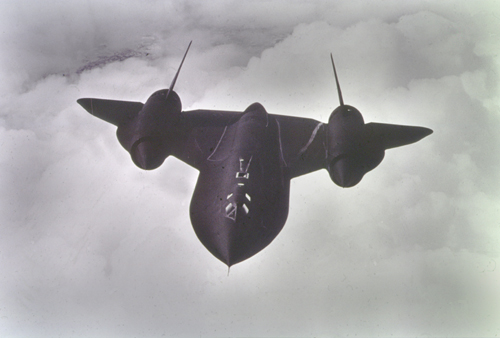 |
| Here’s one that did not get away. One of Bernie’s favorites—he loved flying with a passion—it’s a shot of an SR71 Stealth reconnaissance aircraft, made from the belly of its refueling plane. For a long time, Bernie carried this shot in his wallet. (© the estate of Bernie Boston.) |
But Bernie only laughed at life’s inevitable foul-ups. He knew he had the greatest gig in town.
“Like many colleagues,” noted veteran photojournalist David Burnett, “Bernie WAS a White House photographer. By that I mean, someone who worked at the White House covering events for a paper or a wire service or magazine, and who saw in those public events of very public people, the chance to get a private moment: something which illuminated the personage in ways that no other medium could do.
“He loved DC, he loved the fact that being here meant you were at the center of the action. And I think he shared that feeling which I feel every time I walk past the guard house at the northwest gate: You are entering the White House, the President's House, the People's House; it is never something done lightly.
“There is an aura about the place, no matter who the President is, no matter which party is in power. The House is above all. When you have that kind of appreciation for the White House, it colors your view of your work. You feel an extra obligation to do something special every time you enter those gates. It does not breed mediocrity. Bernie loved being there, loved the idea of covering those events which everyone in the country would learn about that night on TV, or the next morning in their paper. It is a very seductive feel, and not a bad one, really.”
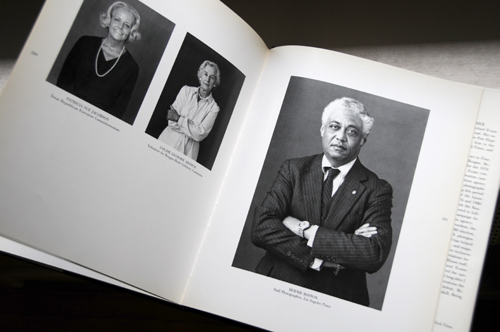 |
In White House Photographer Michael Evans’ 1985 book People and Power Bernie rated a full page among Washington’s Reagan-era movers and shakers. It’s also one of the few times I ever saw Bernie in a tie.
|
Bernie retired from the LA Times in 1993 and he and Peg settled in the Shenandoah Valley. In 2000 they bought and took over the monthly Bryce Mountain Courier.
At monthly meetings of the f.65 group—a Washington luncheon club of “senior” photographers, curators and editors to which we both belonged, Bernie would love showing off the latest edition of the paper. Over the last few years, too, he was never shy about talking about his condition.
“At least I know how I’m gonna die,” he told me the last time I saw him.
Just like Bernie.
Farewell my friend, and pax tibi.
-0-0-0-0-
Frank Van Riper Classes and Field Trips, Spring, 2008
Glen Echo Park Photo Works
Master Class with Dr. Flash
Five-week hands-on studio class helps you master small flash units and studio strobes. Students will learn still life, tabletop and portraiture techniques in step-by-step demonstrations and individual exercises with professional flash gear. (Thursday evening April 3-May 1, 7-10:30pm, $350)
Field Trip, National Gallery East Wing, Sunday, 4/27/08
Endless opportunities for shooting - people, architecture, abstracts in beautiful light. Lunch and discussion at the gallery. A brief organizational meeting will be held prior to the trip at Photoworks and a follow-up potluck at Frank's house. For info, contact instructor at GVR@GVRphoto.com or 202-362-8103. (Sunday, April 27th, 10:30am-4pm; before and after sessions TBA; $150)
Basic Flash Workshop
Four week hands-on workshop will help students get the most out of their small flash units to mimic results obtained with much larger professional gear. This workshop concentrates on the basics, with surprising results. (Thursday evening, May 15-June 5, 7-10:30pm; $275)
Field Trip, National Building Museum, Sunday, 5/18/08
One of Washington's most unusual interiors - the Italian Renaissance building that houses the National Building Museum - and some of the tallest interior columns in the world. Tripods permitted. Briefing meeting appx. one week prior to trip followed by post-trip potluck at Frank's house. For info contact instructor at GVR@GVRphoto.com or 202-362-8103. (Sunday, May 18th , 10:30am-4pm; before and after sessions TBA; $150)
Contact registrar: www.glenechopark.org or GVR@GVRphoto.com
Frank Van Riper is a Washington-based photographer, journalist and author. He served for 20 years in the New York Daily News Washington Bureau as White House correspondent, national political correspondent and Washington bureau news editor, and was a 1979 Nieman Fellow at Harvard. Among others, he is the author of the biography Glenn: The Astronaut Who Would Be President, as well as the photography books Faces of the Eastern Shore and Down East Maine/ A World Apart. His book Talking Photography is a collection of his Washington Post and other photography writing over the past decade. Van Riper’s photography is in the permanent collections of the National Portrait Gallery and the National Museum of American Art in Washington, and the Portland Museum, Portland, Maine. He can be reached through his website www.GVRphoto.com
[Copyright Frank Van Riper. All Rights Reserved. Published 1/08]
|